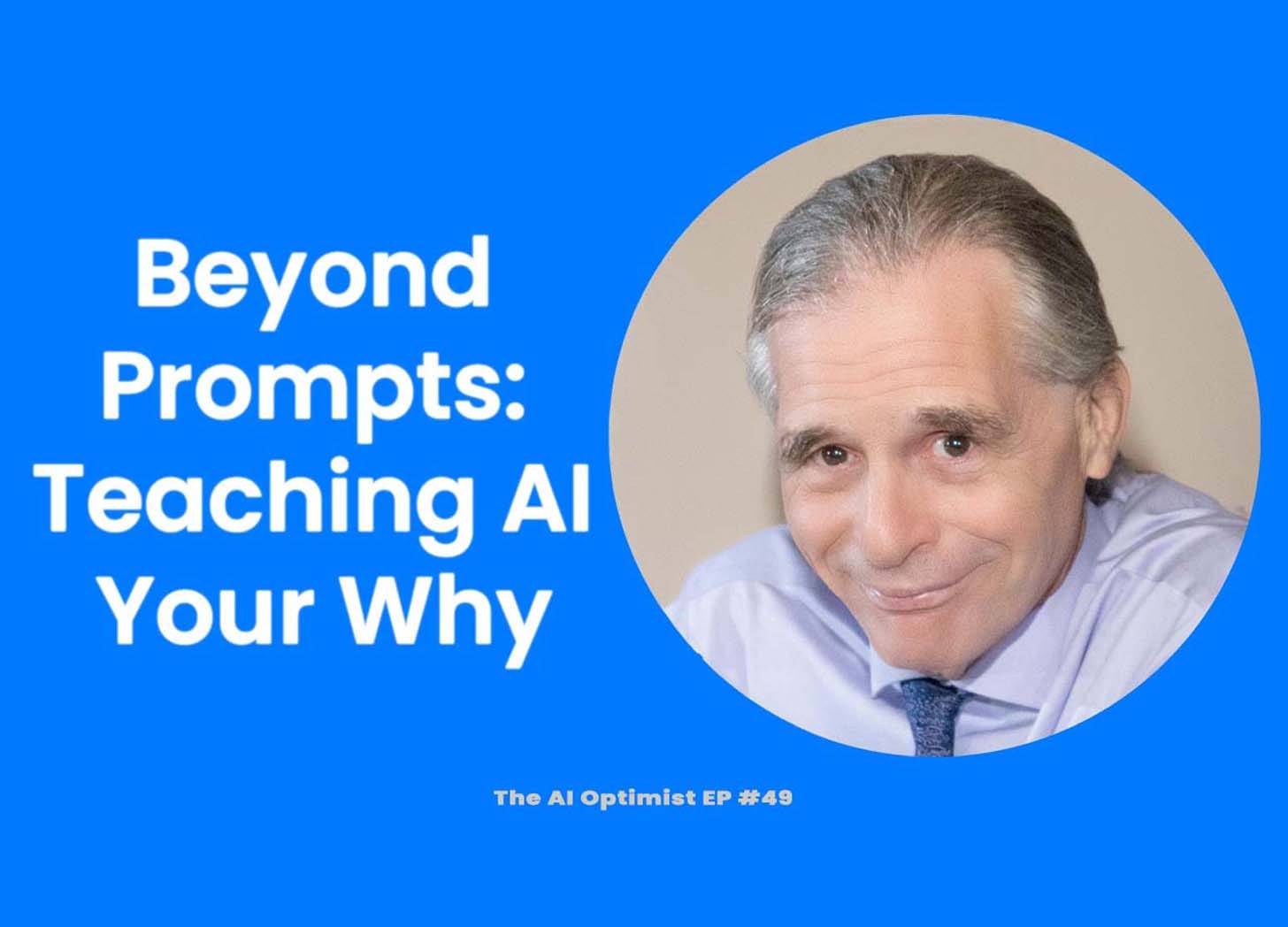Watching that hand go up in the back really nervously asking me a question at the end of a workshop almost made me cringe.
"Where do I buy prompts?"
After teaching people about generative AI, I had to help them figure out just what the data part was.
Giving AI insights and information to frame the question so you get a better answer is crucial. Generative AI determines patterns.
And how do you get better responses? You start with your why - the data behind your prompt.
In business, that means customers clearly communicate their purpose, their actions, their behaviors. And it gets smarter. AI starts learning from the data we collect or generate.
I realized people didn't connect how we get that data to putting it into AI.
So in this episode, let's do like a live class.
I'm going to show you three examples, real examples of funnels that people have created to be able to get information and use this to better target and to use AI to its full advantage.
Let's get started.
Example 1: HelloFresh - Customer Profiling
The first example is HelloFresh, a customer profiling example. They sell meals, and they first ask me my preferences: meat and veggies, veggies, along with four other choices.
How many meals per week and for how many people? Think about that segmentation. That's data.
That's information that becomes associated with my account as I set it up at HelloFresh.
They can then use this to personalize messages to me, to make sure they recommend things I like to eat and cut out the guesswork.
This allows AI in the background to target and put their lists into various segments.
When they send out emails, they will go out based on what I want as a person using their service, not based on guesswork.
They end up sending me an email showing ten free meals designed for the meals I selected.
That's what HelloFresh does - a very simple example of customer profiling, using that to get some idea of what to go for. That's data.
Example 2: StitchFix - Product Recommendations
Now let's go a little deeper into a site called StitchFix. StitchFix sells clothing. First, they have a style quiz to allow me to do product recommendations.
They ask me my gender. Then they get my email. Of course, they're not just saying, "Give me your email and we'll just email you." They need the data.
They need the data to feed. They need to be able to get that segmentation. And they give me $25 off right away.
As you're watching this now, as I give them my phone number, that phone number goes to the next step.
And first, "What are the reasons you're excited to try Stitch Fix?"
Having my own stylist, unique pieces - there are about eight choices, and they allow me to select the boxes. This is telling them my why.
They ask how tall I am. Remember, they're selling clothing. What my weight is.
Now you can obviously skip any questions you want, but think about the profiling they're getting.
Now they're asking me what sizes I typically wear: shirts, waists, inseam, blazers, and shoes.
All this data gives them exactly an ability to recommend products for me going forward, whether going to their website or emailing me.
This allows AI in the back end to personalize, to be able to make recommendations based on me and not based on guessing.
And while StitchFix is a really fancy example, as we go through this, they ask me, "Are you interested in big and tall sizes?
No. Choose how you would like your casual shirts to fit." And they showed two photos visualizing it.
They gather so much information that they know more about me than probably I know about myself.
All this data is so rich because now they're going to help me discover pieces for my best fit.
Example 3: Captivate the Room - Speaker Quiz
Now I'm going to show you the best example from a site called Captivate the Room, which teaches public speakers how to reach their audience.
They start with a speaker quiz: "Unmask your voice personality."
All my friends who do major millions of dollars of ad buying use quiz funnels. So your friends would describe you as a natural-born... It shows me four pictures: peacekeeper, debater... I choose peacekeeper.
They ask emotional questions like, "You've landed the keynote speaker. How do you feel?"
They dive into psychology, asking about your inner critic and how you see yourself. All of this gives you a profile.
What's brilliant about this site is that after you submit your answers, they immediately give you a personalized response.
They told me, "Your voice is what we call 'the actor.'" That's a segment, and it gives you information in a sales letter that's personalized to me from what I just put in there.
They even give me a "voice mask" - they say it's Leonardo DiCaprio in "Catch Me If You Can," which is sort of funny and allows me to have a laugh.
But then it goes into the sales copy, explaining what voice masks are, reaffirming and giving me an explanation.
That's what data does. It allows us to automate this, but also to put this into a sales letter along with addressing the struggles I might face.
The Power of Data in AI
So now in the workshops I'm teaching, I'm trying to make clear what data really does for us. It allows us to actually know the customer.
And in any question or prompt you ask of ChatGPT or any generative AI, you need some background, don't you? Otherwise, it's like walking up to a stranger and asking them a question.
These are fun ways to train AI. Think of data as something that's going to give you a better response.
If you're writing a sales letter, you want to show several different examples. Use recent data, by the way, not old data.
You don't want to use five-year-old customer data. You want to use stuff that's more up to date and trending.
You want to use things that are relevant and not duplicating. You don't want to give two or three examples of the same thing. That's going to confuse AI, unfortunately, and cause it to hallucinate.
So there are fun ways to train AI. Look at the examples in the Captivate the Room speaker quiz. It's like interactive storytelling.
There are stories about you, the user, but it's tied into overall speaker types, where you feel less alone and more identified.
But more importantly, you have data as the business to be able to personalize this and address your needs.
Understanding that data is not this weird, mysterious word - it's just information about behaviors and preferences.
We might even do role-playing games, simulating customer scenarios in the way Captivate the Room did, giving me an actor mask.
What we wanted to share here is that we need to go beyond prompts and start with the why. Maybe it's about consumer business examples I've given here.
Maybe it's asking a scientific question and making sure you include specific PDFs, research data, or websites about what you're doing.
But don't throw the kitchen sink at it. Be picky. Be able to pick a few pieces of data that give an idea of the path you're taking.
When you're working with generative AI, you want to have data in hand so you can ask the right questions to get much better answers and not rely on luck.
It's really brilliant. If you use ChatGPT, it's even smarter if you give it a hint where you're going. Start with your why.
Why are you asking the question, and what information can you share to get a more specific answer?
Extra Resources
Here are some easy-to-understand definitions of data in AI and what it means:
1. Training data:
This is the information AI uses to learn. For example, if you want an AI to recognize dogs, you'd show it thousands of dog pictures.
2. Input data:
This is the new information given to an AI system, like a question you ask a smart peer. Your prompt is input data, plus any attachments and examples.
3. Output data:
This is the result or answer AI produces.
4. Structured data:
This is organized information, like a neatly arranged spreadsheet. It's easy for AI to understand and process.
5. Unstructured data:
This is varied information that doesn't fit neatly into categories. It's like a jumble of notes, pictures, and recordings. Examples include social media posts, emails, or video content.
Data is the fuel that powers the system. Just as humans learn from experience and information, AI systems learn from data. The more relevant and high-quality data an AI system has, the better it performs.
Creating a Data Collection Plan for Small Businesses
Collecting relevant and recent data is key to making informed decisions and effectively training AI.
Here’s a step-by-step guide to creating a data collection plan:
Step 1: Define Your Objectives
· What do you want to achieve?
o Identify specific goals (e.g., improving customer service, personalizing marketing, managing inventory).
o Decide what data you need to reach these goals (e.g., customer purchase history, website behavior, social media interactions).
Step 2: Identify Key Data Sources
· Where will the data come from?
o Customer Interactions: Emails, phone calls, chat logs.
o Sales Records: Purchase history, product returns.
o Website Analytics: Page visits, time spent, clicks.
o Social Media: Engagements, comments, shares.
o Feedback: Surveys, reviews, ratings.
Step 3: Set Up Data Collection Methods
· How will you gather the data?
o Online Forms: Use sign-up forms on your website to collect contact information and preferences.
o Surveys: Send out surveys via email or social media to gather customer feedback.
o Analytics Tools: Implement tools like Google Analytics for website data and social media insights.
o CRM Software: Use Customer Relationship Management software to store and organize customer interaction data.
o Point-of-Sale Systems: Collect sales data directly from your checkout process.
Step 4: Ensure Data Quality
· How will you maintain high-quality data?
o Regular Updates: Keep data fresh by regularly updating your records.
o Validation: Ensure data accuracy by validating customer input (e.g., email verification).
o Consistency: Use standardized formats for data entry to maintain consistency.
Step 5: Filter Out Irrelevant Data
· How will you ensure data relevance?
o Define Criteria: Clearly outline what constitutes relevant data for your goals.
o Regular Reviews: Periodically review your data to remove outdated or irrelevant information.
o Automate Filtering: Use software tools to automatically filter out non-relevant data based on your criteria.
Step 6: Organize and Store Data
· How will you manage and store the data?
o Centralized Storage: Use a central database or cloud storage to keep all data in one place.
o Categorization: Organize data into categories that align with your business goals (e.g., customer feedback, sales data).
o Backup: Regularly back up your data to prevent loss.
What is Training Data?
Training data is the information you give your AI tools to learn from, helping them understand patterns, preferences, and behaviors.
Why Relevant and Recent Data Matter
1. Relevance is Key:
o Weak data leads to poor AI performance. Focus on data that directly relates to your goals.
2. Fresh Data Wins:
o Recent data reflects current trends and preferences. Old data leads to outdated and confusing results.
Fun Ways to Train Your AI:
1. Interactive Storytelling:
o Provide it with your brand’s best stories (data) and let it learn the narrative style and key messages.
2. Customer Journey Maps:
o Create visual maps of customer interactions. Feed your AI with insights into how customers engage with your business.
3. Role-Playing Games:
o Simulate customer scenarios and use these interactions to train your AI.
Examples of Irrelevant Data to Filter Out When Training AI
When training AI, especially for small businesses, focus on the right data to ensure the AI performs accurately and effectively. Irrelevant data you should filter out:
1. Old and Outdated Data:
· Example: Customer purchase records from more than five years ago.
· Why to Filter Out: Consumer behavior and market trends change over time. Old data rarely reflects current preferences leading to inaccurate predictions.
2. Non-Contextual Data:
· Example: Office supply orders or internal employee communications when training AI for customer service.
· Why to Filter Out: This data doesn't provide relevant insights into customer interactions or preferences and confuses the AI.
3. Irrelevant Geographic Data:
· Example: Data from regions where your business doesn’t operate.
· Why to Filter Out: Customer behavior and preferences can vary by region. Including data from irrelevant locations skews AI outputs.
4. Non-Specific Survey Responses:
· Example: General feedback surveys when training for customer experience improvement.
· Why to Filter Out: These surveys don't provide direct insights into customer preferences or behavior.
8. Duplicate or Redundant Data:
· Example: Multiple records of the same customer interaction.
· Why to Filter Out: Duplicate data leads to biased training and overemphasis on certain behaviors or preferences.
· Focus on relevant, recent data that directly impacts your business goals.
· Filter out old, outdated, or non-contextual data to avoid confusing your AI.
· Regularly update your training data to keep it aligned with current trends and behaviors.
Step 7: Train Your AI
· How will you use the data to train AI?
o Relevant Datasets: Use the filtered, organized data to train your AI systems.
o Regular Updates: Continuously feed new, relevant data into your AI to keep it accurate and effective.
o Feedback Loop: Monitor AI performance and refine the data collection process based on results.
Gathering Data: Survey Funnels
A survey funnel is a sequence of questions guiding people through a process, typically to gather information or make recommendations.
Here are some examples of survey funnels:
Example 1: Personality Quiz Funnel
A quiz funnel that asks users a series of questions to determine their personality type, interests, or preferences. The questions are designed to narrow down the options and provide a personalized result at the end.
Example 2: Product Recommendation Funnel
A survey funnel that asks users a series of questions about their preferences, needs, and behaviors to recommend a specific product or service. The questions are designed to gather information about the user’s lifestyle, budget, and goals.
Example 3: Lead Qualification Funnel
A survey funnel that asks users a series of questions to qualify them for a specific service or product. The questions are designed to gather information about the user’s needs, budget, and goals to determine if they are a good fit for the service or product.
Example 4: Customer Profiling Funnel
A survey funnel that asks users a series of questions to create a customer profile. The questions are designed to gather information about the user’s demographics, behavior, and preferences to create a detailed profile.
Example 5: Market Research Funnel
A survey funnel that asks users a series of questions to gather information about their opinions, attitudes, and behaviors related to a specific market or industry. The questions gather data to inform market research and product development.
















